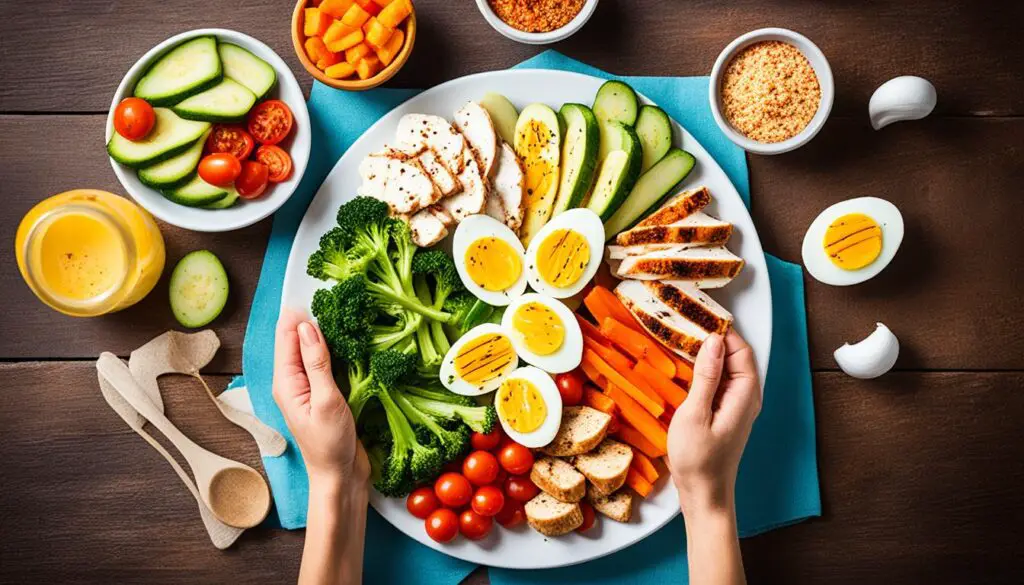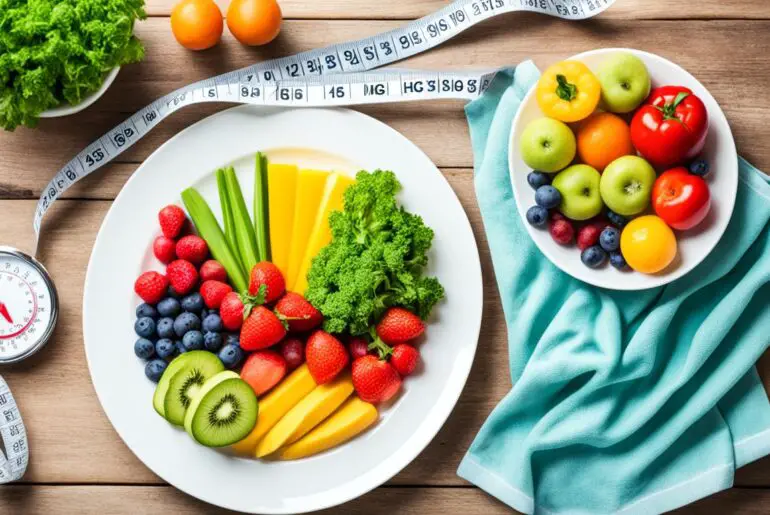Are you struggling to manage hunger while following the HCG Diet protocol? Don’t worry, you’re not alone. Hunger can be a common challenge, especially in the early stages as your body adjusts to the changes. But what if there were strategies that could help you effectively manage hunger and reduce those pesky cravings?
In this article, I will share valuable tips and techniques for managing hunger on the HCG diet. From the role of water in hunger management to the appetite-suppressing effects of coffee and green tea, we will explore various ways to curb hunger and stay on track with your weight loss goals. Are you ready to discover the key to controlling your hunger cravings during the HCG protocol? Let’s dive in!
Key Takeaways:
- Drinking an adequate amount of water can help suppress appetite.
- Coffee and green tea are effective appetite suppressants.
- Spacing out meals and prioritizing protein intake are essential for hunger management.
- Incorporating “free” vegetables can help satisfy hunger while on the HCG Diet.
- Understanding hunger patterns and properly loading at the start of the protocol can contribute to hunger management.
The Role of Water in Hunger Management
When it comes to managing hunger during the HCG protocol, staying hydrated plays a crucial role. Drinking an adequate amount of water, around 2-4 liters per day, not only keeps you hydrated but also helps suppress appetite and reduce the risk of cheating on your diet. Dehydration can often be mistaken for hunger, causing unnecessary cravings and temptations.
To ensure optimal hunger management, make it a priority to drink enough water throughout the day. Sparkling water without any added flavors or natural herbal teas can also serve as alternative hydration options.
By prioritizing water intake and maintaining proper hydration, you can effectively manage hunger cravings and stay on track with your HCG protocol.
Benefits of Water in Hunger Management:
- Suppresses appetite
- Reduces the risk of cheating
- Helps differentiate between hunger and dehydration
- Promotes overall hydration and well-being
Incorporating an adequate water intake into your daily routine is a simple yet powerful strategy for managing hunger during the HCG protocol. By consistently hydrating yourself, you can optimize your weight loss journey and achieve successful results.
The Appetite-Suppressing Effects of Coffee

One effective tool for managing hunger during the HCG protocol is coffee. Coffee has been shown to have appetite-suppressing effects, thanks to its caffeine content. The caffeine in coffee naturally helps control appetite, making it an excellent ally in hunger management while on the HCG protocol.
When consuming coffee during the protocol, it is crucial to drink it black, as the only approved sweetener is Stevia. Adding cream or sugar to your coffee can disrupt the balance of the program and may hinder hunger management efforts.
However, it’s worth mentioning that some individuals may be sensitive to caffeine. If you find that coffee doesn’t work well for appetite suppression or if you experience negative side effects, exploring other options for curbing hunger is recommended.
The caffeine in coffee naturally helps control appetite, making it an excellent ally in hunger management while on the HCG protocol.
The Benefits of Green Tea in Hunger Management
When it comes to managing hunger during the HCG protocol, green tea can be a valuable tool. This popular beverage offers several benefits that can help control appetite and support weight loss.
Green tea contains compounds that have been shown to reduce hunger. One of these compounds inhibits the enzyme responsible for breaking down dopamine and norepinephrine, two neurotransmitters that play a role in appetite regulation. By blocking this enzyme, green tea can help decrease hunger levels and cravings.
Another appetite-suppressing effect of green tea is the release of a substance called CCK (cholecystokinin). CCK is a hormone that signals feelings of fullness to the brain, which can help reduce the desire to eat more. By increasing CCK levels, green tea can contribute to a greater sense of satiety and satisfaction after meals.
Furthermore, green tea has thermogenic properties, meaning it can boost metabolism and increase fat burning. This can be particularly beneficial for individuals following the HCG protocol, as it can help accelerate the breakdown of stored fat for energy while simultaneously curbing hunger.
Green tea can be enjoyed hot or cold, and it is recommended to consume it without any added sweeteners or milk to fully experience its appetite-suppressing effects. Consider incorporating green tea into your daily routine to help manage hunger and support your HCG protocol journey.
| Benefits of Green Tea |
|---|
| Reduces appetite and cravings |
| Increases feelings of fullness |
| Boosts metabolism and fat burning |
Meal Timing and Hunger Management

When it comes to managing hunger during the HCG protocol, finding the right meal timing strategy is essential. The way you structure your meals can have a significant impact on your hunger levels throughout the day. Different individuals may have varying preferences and needs, so it’s important to listen to your body and experiment with different meal timings to find what works best for you.
If you’re someone who finds that spacing out meals helps to keep hunger at bay, consider eating smaller, more frequent meals throughout the day. This approach can help to stabilize blood sugar levels and prevent excessive hunger. By dividing your daily calorie intake into multiple smaller meals, you can maintain a more steady release of energy and avoid the dips in blood sugar that often lead to cravings and overeating.
On the other hand, if you prefer eating larger, more substantial meals, you may find it more beneficial to have one or two larger meals a day. This approach, often referred to as intermittent fasting, can help you feel more satisfied and reduce the frequency of hunger pangs. By consuming your daily calorie allotment in fewer meals, you can also create a larger calorie deficit, potentially leading to more rapid weight loss.
Ultimately, the most effective hunger management strategy will vary from person to person. It’s important to pay attention to your body’s hunger signals and adjust your meal timing accordingly. Remember, the key is to find a rhythm that works for you and supports your overall weight loss goals.
Expert Tip:
“Experiment with different meal timings to determine what strategy works best for managing hunger on the HCG diet. Whether you choose to space out your meals or incorporate intermittent fasting, finding a routine that keeps you satisfied will greatly contribute to your success on the protocol.” – Dr. Emily Johnson, HCG Diet Expert
Hunger Management Strategies Comparison Table:
| Meal Timing Strategy | Key Benefits |
|---|---|
| Spacing out smaller, more frequent meals |
|
| Eating one or two larger meals |
|
The Importance of Adequate Protein Intake
One of the key strategies for managing hunger during the HCG protocol is to prioritize adequate protein intake. Consuming the recommended 3.5-4 ounces of protein per meal is crucial in curbing hunger and promoting satiety.
When you decrease your protein intake, it can lead to increased hunger between meals. Protein is known to be more filling and satisfying compared to carbohydrates and fats. By including enough protein in your meals, you can help prevent excessive hunger and cravings.
Protein plays a vital role in managing hunger during the HCG diet because it takes longer to digest, providing a steady release of energy and keeping you fuller for a longer duration. This can help you stick to the protocol and avoid unnecessary snacking or overeating.
There are various high-quality protein sources that you can incorporate into your HCG diet meals, such as:
- Lean meats like chicken breast, turkey, and lean cuts of beef
- Fish and seafood, including salmon, tuna, and shrimp
- Eggs and egg whites
- Low-fat dairy products like Greek yogurt and cottage cheese
By including a variety of these protein-rich foods in your meals, you can help manage hunger effectively while following the HCG protocol.
| Protein Source | Protein Content (per 100g) |
|---|---|
| Chicken Breast | 31g |
| Turkey Breast | 29g |
| Lean Beef | 26g |
| Salmon | 22g |
| Tuna | 26g |
| Egg (1 large) | 6g |
| Low-Fat Greek Yogurt (100g) | 10g |
| Cottage Cheese (low-fat, 100g) | 12g |
As you can see from the table, these protein-rich foods provide a substantial amount of protein per serving, helping you meet your daily intake requirements. Incorporating them into your meals will not only help manage hunger but also contribute to your overall nutritional needs.
Remember, prioritizing adequate protein intake is crucial for managing hunger during the HCG protocol. By including lean meats, seafood, eggs, and low-fat dairy products in your meals, you can promote satiety and stay on track with your diet goals.
Utilizing “Free” Vegetables for Hunger Management

Incorporating “free” vegetables is a valuable strategy for managing hunger during the HCG protocol. These nutrient-rich options not only provide essential vitamins and minerals but also help alleviate hunger cravings. By including vegetables like celery, cucumber, radishes, lettuce, and cabbage in your meals, you can satisfy your hunger while maintaining compliance with the HCG diet.
These “free” vegetables are low in calories and high in fiber, which contributes to a feeling of fullness. Their high water content adds volume to your meals without significantly impacting your calorie intake. By incorporating larger quantities of these vegetables, you can satiate your hunger and prevent overeating.
In addition to their appetite-controlling properties, “free” vegetables offer a psychological boost. Knowing that you can consume satisfying portions of these vegetables can help you stay motivated and committed to the HCG protocol.
Here are a few tips for utilizing “free” vegetables for hunger management during the HCG protocol:
- Include a variety of “free” vegetables in your meals to add flavor and texture
- Experiment with different recipes and cooking methods to keep your meals interesting
- Consider incorporating these vegetables into salads, soups, or stir-fries
- Make sure to wash and prepare the vegetables properly before consumption
By making “free” vegetables a staple in your HCG protocol meals, you can effectively manage hunger cravings and stay on track with your weight loss journey.
Understanding Hunger Patterns on the HCG Protocol

Hunger patterns can vary during the HCG protocol, and it’s important to understand and manage them effectively. In the early stages of the protocol, it’s common to experience more pronounced hunger as your body adjusts to the new dietary restrictions. This can be challenging, but it’s a temporary phase that will pass as your body adapts.
Typically, hunger tends to peak between days 4 to 6 of the protocol. This is the time when your body is still transitioning and hasn’t fully tapped into your stored fat as an energy source. However, as the HCG hormone kicks in and starts mobilizing and converting stored fat into energy, hunger tends to subside.
To maintain the hunger-suppressing effects of the HCG hormone, it’s important to keep your carbohydrate intake below 30 grams per day. This helps your body stay in a state of ketosis, where it primarily relies on fat for energy rather than carbohydrates. By staying in ketosis, you can continue to benefit from the appetite-suppressing properties of the HCG hormone, making hunger more manageable.
Understanding the hunger patterns on the HCG protocol allows you to anticipate and manage your hunger effectively. It’s important to stay committed to the protocol and trust the process, knowing that hunger will diminish as your body adapts and starts utilizing stored fat for energy.
The Importance of Proper Loading
Proper loading is a crucial phase of the HCG protocol when it comes to managing hunger and achieving success. While it may seem counterproductive, loading your body with high-fat foods serves a purpose. By consuming these foods, you create an immediate calorie reserve that sustains you during the initial days when hunger peaks.
Increasing your fat consumption during this stage also jump-starts the metabolization of fat, which aids in weight loss. Fatty foods, especially those rich in healthy Omega-3 fats, such as salmon, avocado, and nuts, are ideal choices for loading.
During this period, focus on nourishing your body with these high-fat foods to establish a strong foundation for hunger management throughout the HCG protocol.
Meal Preparation and Avoiding Temptation

When following the HCG protocol, meal preparation plays a crucial role in managing hunger and staying on track. By setting aside just 15 minutes each day to plan and prepare your meals, you can make a significant difference in hunger management and avoid the temptation to deviate from the protocol.
Preparing your meals ahead of time ensures that you have nutritious options readily available, reducing the likelihood of making unhealthy food choices when hunger strikes. By having your meals planned and ready to go, you can eliminate the stress and guesswork of deciding what to eat, allowing you to stay focused on your HCG journey.
By incorporating the following tips into your meal preparation routine, you can effectively manage hunger and set yourself up for success:
- Create a weekly meal plan:
- Batch cook:
- Divide meals into portions:
- Keep snacks on hand:
- Use kitchen tools for efficiency:
Plan your meals for the week, taking into consideration the HCG protocol guidelines and your personal preferences. This will help you stay organized and ensure that you have a variety of nutritious options to choose from.
Spend a designated day each week batch cooking your proteins, vegetables, and other approved foods. This will save you time and streamline your meal preparation process.
Once your meals are cooked, divide them into portion-sized containers. This makes it easy to grab a meal when hunger strikes without the need for additional preparation or decision-making.
Prepare healthy snacks, such as cut vegetables or portioned fruit, and keep them easily accessible. Having these options readily available will help curb cravings and prevent you from reaching for less healthy choices.
Invest in kitchen tools that make meal preparation quicker and easier. For example, a food processor can help you chop vegetables in no time, and a slow cooker allows you to cook meals while you’re busy with other tasks.
Remember, the key to successful meal preparation and hunger management during the HCG protocol is to stay organized, plan ahead, and prioritize nutritious options.
“Meal preparation is the foundation of success on the HCG protocol. By setting aside a little time each day and following a plan, you can avoid the temptation to deviate from the protocol and make conscious, healthy choices.”
Stay committed to your goals and the HCG protocol by implementing a meal preparation routine that works for you. With a little bit of effort and planning, you can stay on track, manage hunger effectively, and achieve the results you desire.
Now, let’s take a look at the table below for a visual representation of how proper meal preparation can help manage hunger during the HCG protocol:
| Advantages | Disadvantages | |
|---|---|---|
| Meal Preparation |
|
|
“Cheat” Foods for Hunger Relief

While managing hunger during the HCG protocol is crucial, there are a few food items that can provide temporary relief without compromising progress. These “cheat” foods can help satisfy cravings and ease hunger pangs. Here are some options to consider:
- Green vegetables with negative calories, such as celery and lettuce, can be consumed in larger quantities to create a feeling of fullness without adding excessive calories.
- Chicken bouillon, with its low calorie content, can be sipped to create a sense of satiety. It is a warm and comforting option that can help curb hunger.
- Quality beef jerky, which is protein-rich, can be a satisfying snack between meals. It provides a boost of energy and helps keep hunger at bay.
Additionally, some individuals find that brushing their teeth when hunger strikes can help distract from cravings. The act of brushing can create a refreshed feeling and reduce the desire to eat. Remember, these “cheat” foods should be used sparingly and in moderation, adhering to the HCG guidelines.
Through strategic hunger management and the incorporation of these “cheat” foods, individuals can navigate the HCG protocol with greater ease. It is important to find a balance between hunger relief and staying on track to achieve diet success.
Conclusion
Successfully managing hunger during the HCG protocol is crucial for achieving diet success. By implementing various techniques and strategies, individuals can effectively control hunger cravings and navigate the protocol more comfortably.
Staying hydrated is key in hunger management during the HCG protocol. Drinking an adequate amount of water, around 2-4 liters per day, helps suppress appetite and reduce the risk of cheating. Coffee and green tea, known appetite suppressants, can also be beneficial additions to the diet.
Proper meal timing and ensuring adequate protein intake are essential. Spacing out meals and never skipping recommended protein portions helps promote satiety and prevent excessive hunger. Incorporating “free” vegetables, such as celery and lettuce, can provide fiber and volume, helping to satisfy hunger without significantly impacting calorie intake.
Understanding hunger patterns and properly loading at the start of the protocol also contribute to hunger management. By following these guidelines, individuals can effectively manage hunger, stay compliant with the HCG protocol, and maintain their diet success.
FAQ
How can I manage hunger during the HCG protocol?
Hunger can be managed during the HCG protocol by implementing strategies such as staying hydrated, consuming appetite-suppressing foods and beverages, spacing out meals, prioritizing protein intake, and incorporating “free” vegetables. It is also important to understand hunger patterns and properly load at the start of the protocol.
What role does water play in hunger management during the HCG protocol?
Staying hydrated is key in managing hunger during the HCG protocol. Drinking 2-4 liters of water per day can help suppress appetite and reduce the risk of cheating. Sparkling water without any added flavors or tea can also be alternative options for hydration.
How can coffee help in managing hunger during the HCG protocol?
Coffee has been shown to be an effective appetite suppressant. The caffeine in coffee helps control appetite naturally. It is important to consume coffee black as the only approved sweetener on the program is Stevia.
What are the benefits of green tea in hunger management during the HCG protocol?
Green tea is another well-known appetite suppressant that can be helpful in managing hunger during the HCG protocol. It contains compounds that can reduce appetite and assist with weight loss. The thermogenic properties of green tea also contribute to fat burning.
How does meal timing affect hunger management during the HCG protocol?
Finding the right meal timing strategy can play a significant role in managing hunger while on the HCG protocol. Some individuals may benefit from spacing out their meals, while others may prefer eating one large meal. It is crucial to listen to your body and find a rhythm that works best for you.
How important is adequate protein intake in hunger management during the HCG protocol?
Ensuring that you consume the recommended 3.5-4 ounces of protein per meal is essential in managing hunger during the HCG protocol. Decreasing protein intake can lead to increased hunger between meals.
How can "free" vegetables help in managing hunger during the HCG protocol?
Incorporating “free” vegetables, such as celery and lettuce, can be an effective strategy for managing hunger during the HCG protocol. These vegetables provide fiber and volume, helping to alleviate hunger. They can be consumed in larger quantities without significantly impacting calorie intake.
What should I know about hunger patterns on the HCG protocol?
Hunger patterns may vary during the HCG protocol. In the early stages, hunger may be more prominent as the body adjusts to the new dietary restrictions. Typically, hunger peaks between days 4 to 6 of the protocol. However, as the HCG hormone starts to tap into stored fat and convert it into energy, hunger tends to subside.
Why is proper loading important in hunger management during the HCG protocol?
Proper loading, despite seeming counterproductive, is an essential phase of the HCG protocol. Loading with high-fat foods helps create an immediate calorie reserve, sustaining you during the initial days when hunger peaks. Increasing fat consumption also jump-starts the metabolization of fat, aiding in weight loss.
How can meal preparation help in hunger management during the HCG protocol?
Preparing meals ahead of time can help avoid temptations and maintain compliance with the HCG protocol. By ensuring that you have nutritious meals readily available, you can resist the temptation to deviate from the protocol and make unhealthy food choices.
Are there any "cheat" foods that can provide temporary relief from hunger during the HCG protocol?
While it is essential to strictly adhere to the HCG protocol, there are a few food items that can provide temporary relief from hunger without compromising overall progress. Green vegetables, chicken bouillon, and quality beef jerky can be consumed in moderation to help satisfy hunger between meals.
What are some concluding thoughts on managing hunger during the HCG protocol?
Managing hunger during the HCG protocol is crucial for diet success. By implementing strategies such as staying hydrated, consuming appetite-suppressing foods, spacing out meals, prioritizing protein intake, and incorporating “free” vegetables, individuals can effectively curb hunger cravings.




